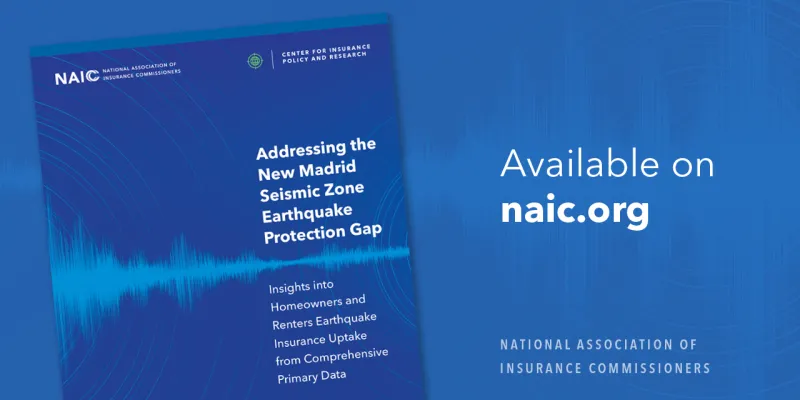
New Madrid Seismic Zone Report Highlights Earthquake Insurance Gap
Missouri Department of Commerce and Insurance, NAIC Center for Insurance Policy and Research, and MU Disaster and Community Crisis Center Announce Homeowners and Renters Earthquake Insurance Report
On Monday, the Missouri Department of Commerce and Insurance (DCI), the National Association of Insurance Commissioners’ (NAIC) Center for Insurance Policy and Research (CIPR), and the University of Missouri’s Disaster and Community Crisis Center announced the release of a new report addressing the New Madrid Seismic Zone earthquake protection gap and providing insights into homeowners and renters insurance uptake.
The New Madrid Seismic Zone (NMSZ), located in the central United States, is one of the most active earthquake zones in the country, averaging more than 200 small earthquakes per year. In 1811 and 1812, this zone produced some of the largest earthquakes in U.S. history, estimated at magnitudes 7.0-7.5. Several studies have projected what the losses would be if a similar magnitude earthquake event were to occur in the NMSZ region today, with estimates ranging from $110 to $290 billion in total insured losses.
Since 1974, a total of more than 4,000 earthquakes have been recorded in the NMSZ, and scientific experts estimate there is a 25 to 40 percent chance of another large magnitude earthquake occurring in the next 50 years.
Despite the threat, a substantial and growing gap of earthquake insurance coverage protection exists in the area. Missouri DCI produces annual estimates of residential insurance coverage in their state. The most recent data from 2021 shows earthquake coverage in the New Madrid region of Missouri has decreased 49 percent from 2000 (60 percent), while earthquake coverage costs there have increased 816 percent. Region-wide, an estimated 7-16 percent of homeowners report having earthquake insurance.
The study explores other reasons beyond cost and availability that might impact a consumer’s decision to purchase earthquake insurance coverage. The study found that the top three predictors of earthquake insurance uptake were:
- Using agents to help make insurance decisions
- Talking to friends and family about earthquakes
- Confidence in having sufficient information about earthquakes
Another key finding was that many homeowners were unaware that their standard insurance policy doesn’t cover damage and losses suffered from an earthquake. Missouri DCI is incorporating the findings of this study into its annual education and awareness campaign to give consumers more information to make critical decisions about their coverage and preparedness.
For questions about the report or data, contact the NAIC Center for Insurance Policy and Research. For questions about the consumer education and awareness program, contact the Missouri Department of Commerce and Insurance.
About the National Association of Insurance Commissioners
As part of our state-based system of insurance regulation in the United States, the National Association of Insurance Commissioners (NAIC) provides expertise, data, and analysis for insurance commissioners to effectively regulate the industry and protect consumers. The U.S. standard-setting organization is governed by the chief insurance regulators from the 50 states, the District of Columbia and five U.S. territories. Through the NAIC, state insurance regulators establish standards and best practices, conduct peer reviews, and coordinate regulatory oversight. NAIC staff supports these efforts and represents the collective views of state regulators domestically and internationally.
